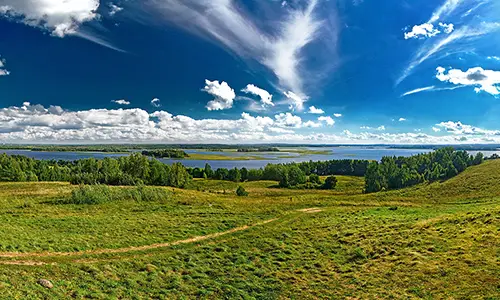The Republic of Belarus (meaning “White Russia”) is one of the 48 landlocked countries of the world situated in Eastern Europe and surrounded by land with only its coastlines lying on closed seas. Its capital city is Minsk, which is also its largest city. Often referred to as the “Country ofCastles,” or the “Blue-Eyed” country, the place has a lot more in stock for us to reveal. Learn more about the country and its uniqueness.
1. The country is bordered by Russia, Ukraine, and Poland on its northeast, south, and west sides and by Lithuania and Latvia on its northwest side.
2. The country houses a recorded population of 9,481,000 according to 2014 files, out of which 4.5 million people are employed. The country code is +375, and the currency used is Belarusian ruble (BYR).
3. The country is spread out in an area of 207,600 square kilometers, and the national registered language is Belarusian, though Russian is also spoken.
4. Besides Minsk, its other renowned cities are Brest, Hrodna, Homiel, Mahilioŭ, and Vitebsk.
5. It was formerly the Belorussian Soviet Socialist Republic of the USSR and then was named Byelorussia, followed by Belarus.
6. Forty percent of the total land is forests, but its marshes are used as a valuable resource. It’s primarily a mountainous plain with numerous rivers and lakes flowing, with Narach (@ 79.6 sq. km) being its largest lake.
7. Peat is the country’s most valuable resource. However, other natural resources Belarus is famous for are clay, sand, wood, limestone, chalk, potassium salt, etc. Lumbering, manufacturing, and other service industries are also vital.
8. Agriculture strives on grain, potatoes, dairy, sugar beet, flax, meat, and other vegetables. Main industries are food and light plants, chemical and petrochemical, metallurgical, and mechanical engineering.
9. Belarus celebrates its National Holiday on July 3, which is its Independence Day. Belarus gained independence from the Soviet Union in 1990.
10. Its present president and prime minister are Alexander Lukashenko (1994-present) and Andrei Kobyakov (2014) respectively. It also has a National Assembly.
11. Belarus has in total 31 banks, out of which 30 banks are government owned and only one is privately owned.
12. Independence Avenue (in Minsk) is the largest stretched road of the country and one of the largest roads in Europe. However, to this date, its name has been changed 14 times.
13. Their National Library is also one of the largest libraries in the world, measuring 72.6 meters high.
14. Though not popular today, the Belarusian partisan movement was the chief opposing movement during the Second World War.
15. Every city will have a Lenin Street and at least one monument dedicated to Vladimir Lenin, the popular Russian communist revolutionary, politician, and political theorist.
16. Since the age of the Grand Duchy of Lithuania, the national culinary traditions have been a mix of Baltic, Slavic, Jewish, and partly German cuisines.
17. The “Pripyat National Park” is the only park in the world with reserves of ancient floodplain oak forests.
18. The government sponsors annual cultural festivals including Slavianski Bazaar, which takes place in Vitebsk. Their Victory Day is also celebrated on a large scale.
19. Religion note: Eastern Orthodox, 80%; Other, 20% (including Roman Catholic, Protestant, Jewish, and Muslim).
20. Ethnicity/race note: Belarusian, 83.7%; Russian, 8.3%; Polish, 3.1%; Ukrainian, 1.7%; other, 2.4%; unspecified, 0.9% (2009 estimate). The literacy rate is 99.6% (as per 2009 records).
Five things to not miss if you are there:
1. Visit Polotsk—the most ancient city of the country;
2. Eat draniki—one of the most famous dishes;
3. Visit the rural farms and attend their festivals;
4. Visit the National Library; and
5. Take a ride on the Independence Avenue Road, a nominator for UNESCO Heritage site.











Leave a Reply